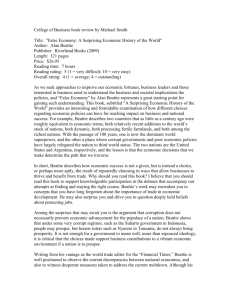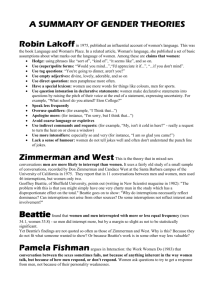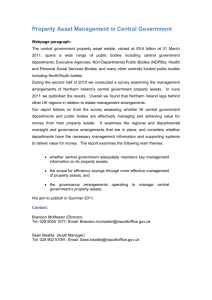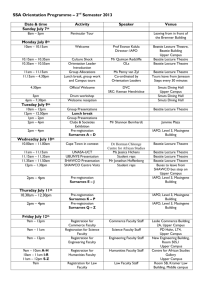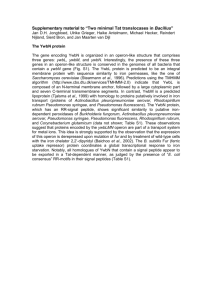Beattie (02-2015) - Plant Pathology and Microbiology
advertisement
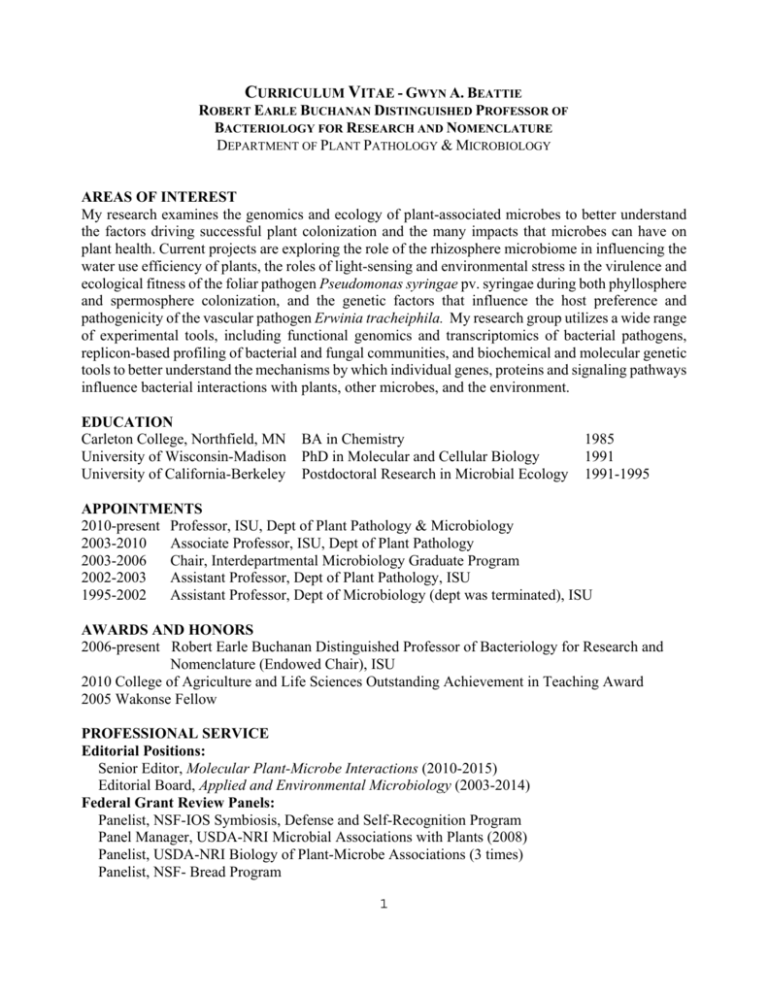
CURRICULUM VITAE - GWYN A. BEATTIE ROBERT EARLE BUCHANAN DISTINGUISHED PROFESSOR OF BACTERIOLOGY FOR RESEARCH AND NOMENCLATURE DEPARTMENT OF PLANT PATHOLOGY & MICROBIOLOGY AREAS OF INTEREST My research examines the genomics and ecology of plant-associated microbes to better understand the factors driving successful plant colonization and the many impacts that microbes can have on plant health. Current projects are exploring the role of the rhizosphere microbiome in influencing the water use efficiency of plants, the roles of light-sensing and environmental stress in the virulence and ecological fitness of the foliar pathogen Pseudomonas syringae pv. syringae during both phyllosphere and spermosphere colonization, and the genetic factors that influence the host preference and pathogenicity of the vascular pathogen Erwinia tracheiphila. My research group utilizes a wide range of experimental tools, including functional genomics and transcriptomics of bacterial pathogens, replicon-based profiling of bacterial and fungal communities, and biochemical and molecular genetic tools to better understand the mechanisms by which individual genes, proteins and signaling pathways influence bacterial interactions with plants, other microbes, and the environment. EDUCATION Carleton College, Northfield, MN University of Wisconsin-Madison University of California-Berkeley BA in Chemistry PhD in Molecular and Cellular Biology Postdoctoral Research in Microbial Ecology 1985 1991 1991-1995 APPOINTMENTS 2010-present Professor, ISU, Dept of Plant Pathology & Microbiology 2003-2010 Associate Professor, ISU, Dept of Plant Pathology 2003-2006 Chair, Interdepartmental Microbiology Graduate Program 2002-2003 Assistant Professor, Dept of Plant Pathology, ISU 1995-2002 Assistant Professor, Dept of Microbiology (dept was terminated), ISU AWARDS AND HONORS 2006-present Robert Earle Buchanan Distinguished Professor of Bacteriology for Research and Nomenclature (Endowed Chair), ISU 2010 College of Agriculture and Life Sciences Outstanding Achievement in Teaching Award 2005 Wakonse Fellow PROFESSIONAL SERVICE Editorial Positions: Senior Editor, Molecular Plant-Microbe Interactions (2010-2015) Editorial Board, Applied and Environmental Microbiology (2003-2014) Federal Grant Review Panels: Panelist, NSF-IOS Symbiosis, Defense and Self-Recognition Program Panel Manager, USDA-NRI Microbial Associations with Plants (2008) Panelist, USDA-NRI Biology of Plant-Microbe Associations (3 times) Panelist, NSF- Bread Program 1 Panelist, NSF-USDA Joint Program in Microbial Genome Sequencing Service to Professional Societies in last 10 years: Member, American Phytopathological Society (APS) Public Policy Board (2014-present) Invited participant, APS Thought Leaders Meeting (2013) Panel member, APS competition for “The Schroth Faces of the Future Symposium” (2012) Invited participant, American Academy of Microbiology Colloquium on “How microbes can help feed the world”, Washington, D.C. (2012) Chair, APS Phyllosphere Committee (2008-2009) Chair, APS Bacteriology Committee (2003-2004) Member, APS Bacteriology and Phyllosphere Committees (2007-2008) Service at Professional Conferences in last 10 years: Organizing Committee, 10th International Symposium on Phyllosphere Microbiology, Ascona, Switzerland, July 19-23, 2015 Steering Committee, Phytobiomes 2015: Designing a New Paradigm for Crop Improvement, Washington DC, June 29-July 2, 2015 Session Co-organizer on “Understanding Phytobiomes to Improve Agricultural Productivity”, APS meeting, Minneapolis, MN, August 9-13, 2014. Session Organizer, 14th International Society for Microbial Ecology, Copenhagen, Denmark, August 19-24, 2012 Judge for the Graduate Student Oral Presentation Competition, North Central American Society for Microbiology Meeting, Des Moines, IA (2011) Organizing Committee, 9th International Symposium on the Microbiology of Aerial Plant Surfaces, Corvallis, Oregon, August 14-18, 2010 Judge for the Graduate Student Oral Presentation Competition, North Central American Phytopathological Society Meeting, Ames, IA (2009) Invited participant, APS 101: Early Career Professionals Informational Social, American Phytopathological Society Conference, San Diego, CA (2007) TEACHING Bacterial-Plant Interactions (Pl P 477/577, 3 cred, Alt Spr) Biology of Microorganisms (Micro 302, 3 cred, Alt Fall) Microbial Ecology and Environmental Monitoring (Micro 556, 1 cred, Spr) Responsible Conduct of Research for Faculty, Postdocs and Staff (0 Cred, Alt Fall) MENTORING Advisor (current/career total): Post-doctoral researchers (1/6), Ph.D. students (3/7), M.S. (0/3), Undergraduate researchers and interns (37), High school teacher and student interns (9) Mentor, ISU Preparing Future Faculty Program (4 graduate students and 2 post-docs since 2006) Faculty co-mentor, Assistant Professor of Plant Pathology (2004-2010) Peer Mentor Coordinator for new faculty, College of Agriculture and Life Science (since 2007) PEER-REVIEWED PUBLICATIONS (38) Saalau Rojas, E., J. C. Batzer, G. A. Beattie, S. J. Fleischer, L. R. Shapiro, M. A. Williams, R. Bessin, B. D. Bruton, T. J. Boucher, L. C. H. Jesse and M. L. Gleason. 2015. Bacterial wilt of cucurbits: Resurrecting a classic pathosystem. Plant Disease (in revision). 2 Yu, X., S. P. Lund, J. W. Greenwald, A. H. Records, R. A. Scott, D. Nettleton, S. E. Lindow, D. C. Gross and G. A. Beattie. 2014. Transcriptional analysis of the global regulatory networks active in Pseudomonas syringae during leaf colonization. mBio 5:e01683-14. doi: 0.1128/mBio0168314 Freeman, B. C., C. Chen, X. Yu, L. Nielsen, K. Peterson and G. A. Beattie. 2013. Physiological and transcriptional responses to osmotic stress of two Pseudomonas syringae strains that differ in epiphytic fitness and osmotolerance. Journal of Bacteriology 195:4742-4752. doi: 10.1128/JB.00787-13 Chen, C., S. Li, D. R. McKeever and G. A. Beattie. 2013. The widespread plant-colonizing bacterial species Pseudomonas syringae detects and exploits an extracellular pool of choline in hosts. The Plant Journal. 75:891-901. doi: 10.1111/tpj.12262 Wu, L, R. S. McGrane and G. A. Beattie. 2013. Light regulation of swarming motility in Pseudomonas syringae integrates signaling pathways mediated by a bacteriophytochrome and a LOV protein. mBio 3:e00334-13. doi: 10.1128/mBio.00334-13 Li, S., X. Yu, G. A. Beattie. 2013. Glycine betaine catabolism contributes to Pseudomonas syringae tolerance to hyperosmotic stress by relieving betaine-mediated suppression of compatible solute synthesis. Journal of Bacteriology 10:2415-2423. doi: 10.1128/JB.00094-13 Yu, X., S. P. Lund, R. A. Scott, J. W. Greenwald, A. H. Records, D. Nettleton, S. E. Lindow, D. C. Gross, and G. A. Beattie. 2013. Transcriptional responses of Pseudomonas syringae to growth in epiphytic versus apoplastic leaf sites. Proc Natl Acad Sci USA, 110:E425-E434. doi: 10.1073/pnas.1221892110 Beattie, G. A. 2011. Water relations in the interaction of foliar bacterial pathogens with plants. Annu Rev Phytopathol 49:533-555. doi: 10.1146/annurev-phyto-073009-114436 Malek, A. A., C. Chen, M. J. Wargo, G. A. Beattie, and D. A. Hogan. 2011. Roles of three transporters, CbcXWV, BetT1 and BetT3, in Pseudomonas aeruginosa choline uptake for catabolism. J Bacteriol,193:3033-3041. doi: 10.1128/JB.00160-11 Freeman, B. F., C. Chen and G. A. Beattie. 2010. Identification of the trehalose biosynthetic loci of Pseudomonas syringae and their contribution to fitness in the phyllosphere. Environ Microbiol, 12:1486-1497 doi: 10.1111/j.1462-2920.2010.02171.x Chen, C., A. A. Malek, M. J. Wargo, D. A. Hogan, and G. A. Beattie. 2010. The ATP-binding cassette transporter Cbc (choline/betaine/carnitine) recruits multiple substrate-binding proteins with strong specificity for distinct quaternary ammonium compounds. Mol Microbiol 75:29-45. Doi: 10.1111/j.1365-2958.2009.06962.x Freeman, B. C. and G. A. Beattie. 2009. Bacterial growth restriction during host resistance to Pseudomonas syringae is associated with leaf water loss and localized cessation of vascular activity in Arabidopsis thaliana. Mol Plant-Microbe Interact 22:857-867. doi: 10.1094/MPMI22-7-0857 Sandhu, A., L. J. Halverson, and G. A. Beattie. 2009. Identification and genetic characterization of phenol-degrading bacteria from leaf microbial communities. Microb Ecol 57:276–285. doi: 10.1007/s00248-008-9473-9 Chen, C. and G. A. Beattie. 2008. Pseudomonas syringae BetT is a low affinity choline transporter that is responsible for superior osmoprotection by choline over glycine betaine. J Bacteriol 190:2717-2725. doi: 10.1128/JB.01585-07 Freeman, B. C. and G. A. Beattie. 2008. An overview of plant defenses against pathogens and herbivores. The Plant Health Instructor. doi: 10.1094/PHI-I-2008-0226-01. Chen, C. and G. A. Beattie. 2007. Characterization of the osmoprotectant transporter OpuC from Pseudomonas syringae and demonstration that cystathionine-β-synthase domains are required 3 for its osmoregulatory function. Journal of Bacteriology, 189:6901-6912. doi: 10.1128/JB.00763-07 Beattie, G. A. and Seibel, J. S. 2007. Uptake and localization of gaseous phenol and p-cresol in plant leaves. Chemosphere, 68:528-536. doi: 10.1016/j.chemosphere.2006.12.070 Carter, C., R. Healey, N. M. O’Tool, S. S. M. Naqvi, G. Ren, S. Park, G. A. Beattie, H. T. Horner, and R. W. Thornburg. 2007. Tobacco nectaries express a novel NADPH oxidase implicated in the defense of floral reproductive tissues against microorganisms. Plant Physiology, 143: 389399. doi: 10.1104/pp.106.089326 Sandhu, A., L. J. Halverson and G. A. Beattie. 2007. Bacterial degradation of airborne phenol in the phyllosphere. Environmental Microbiology, 9:383-392; Highlighted in Nature Reviews in Microbiology 4:880-881. doi: 10.1111/j.1462-2920.2006.01149.x Wright, C. A. and G. A. Beattie. 2005. Bacterial species specificity in proU osmoinducibility and nptII and lacZ expression. Journal of Molecular Microbiology and Biotechnology 8:201-208. doi: 10.1159/000086701 Wright, C. A. and G. A. Beattie. 2004. Pseudomonas syringae pv. tomato cells encounter inhibitory levels of water stress during the hypersensitive response of Arabidopsis thaliana. Proceedings of the National Academy of Sciences USA 101:3269-3274. doi: 10.1073/pnas.0400461101 Casavant, N. C., D. Thompson, G. A. Beattie, G. J. Phillips, and L. J. Halverson. 2003. Use of a site-specific recombination-based biosensor for detecting bioavailable toluene and related compounds on roots. Environmental Microbiology 5:238-249. doi: 10.1046/j.14622920.2003.00420.x Sabaratnam, S. and G. A. Beattie. 2003. Differences between Pseudomonas syringae pv. syringae and Pantoea agglomerans in epiphytic versus endophytic colonization of leaves. Applied and Environmental Microbiology 69:1220-1228. doi: 10.1128/AEM.69.2.1220-1228.2003 Marcell, L. M. and G. A. Beattie. 2002. The effect of leaf surface waxes on leaf colonization by Pantoea agglomerans and Clavibacter michiganensis. Molecular Plant-Microbe Interactions 15:1236-1244. doi: 10.1094/MPMI.2002.15.12.1236 Axtell, C. A. and G. A. Beattie. 2002. Construction and characterization of a proU-gfp transcriptional fusion that measures water availability in a microbial habitat. Applied and Environmental Microbiology 68:4604-4612. doi: 10.1128/AEM.68.9.4604-4612.2002 Beattie, G. A. and L. M. Marcell. 2002. Comparative dynamics of adherent and non-adherent bacterial populations on maize leaves. Phytopathology 92:1015-1023. doi: 10.1094/PHYTO.2002.92.9.1015 Casavant, N. C., G. A. Beattie, G. Phillips, and L. J. Halverson. 2002. Site-specific recombinationbased genetic system for reporting transient or low-level gene expression. Applied and Environmental Microbiology 68:3588-3596. doi: 10.1128/AEM.68.7.3588-3596.2002 Beattie, G. A. and L. M. Marcell. 2002. Effect of alterations in cuticular wax biosynthesis on the physicochemical properties and topography of maize leaf surfaces. Plant Cell and Environment 25:1-16. doi: 10.1046/j.0016-8025.2001.00804.x Beattie, G. A. and S. E. Lindow. 1999. Bacterial colonization of leaves: a spectrum of strategies. Phytopathology 89:353-359. doi: 10.1094/PHYTO.1999.89.5.353 Andersen, G. L., G. A. Beattie and S. E. Lindow. 1998. Molecular characterization and sequence of a methionine biosynthetic locus from Pseudomonas syringae. Journal of Bacteriology 180:44974507. Beattie, G. A. and S. E. Lindow. 1995. The secret life of foliar bacterial pathogens on leaves. Annual Review of Phytopathology 33:145-172. doi: 10.1146/annurev.py.33.090195.001045 4 Beattie, G. A. and S. E. Lindow. 1994. Survival, growth and localization of epiphytic fitness mutants of Pseudomonas syringae on leaves. Applied and Environmental Microbiology 60:3790-3798. Beattie, G. A. and S. E. Lindow. 1994. Comparison of the behavior of epiphytic fitness mutants of Pseudomonas syringae under controlled and field conditions. Applied and Environmental Microbiology 60:3799-3808. Lindow, S. E., G. Andersen and G. A. Beattie. 1993. Characteristics of insertional mutants of Pseudomonas syringae with reduced epiphytic fitness. Applied and Environmental Microbiology 59:1593-1601. Beattie, G. A. and J. Handelsman. 1993. Evaluation of a strategy for identifying nodulation competitiveness genes in Rhizobium leguminosarum biovar phaseoli. Journal of General Microbiology 139:529-538. Beattie, G. A. and J. Handelsman. 1989. Quantitative comparison of the laboratory and field competitiveness of Rhizobium leguminosarum biovar phaseoli. Applied and Environmental Microbiology 55:2755-2761. Beattie, G. A. and J. Handelsman. 1989. A rapid method for the isolation and identification of Rhizobium from root nodules. Journal of Microbiological Methods 9:29-33. PUBLISHED BOOK CHAPTERS Beattie, G. A., C. Chen, L. Nielsen and B. C. Freeman. 2015. Interstrain variation in the physiological and transcriptional responses of Pseudomonas syringae to osmotic stress. In: F. de Bruijn (ed), Stress and Environmental Control of Gene Expression in Bacteria, Wiley-Blackwell Publishers. (In press) Beattie, G. A. 2006. Plant-associated bacteria: Survey, molecular phylogeny, genomics and recent advances, pp. 1-56. In S. S. Gananamanickan (ed), Plant-Associated Bacteria. Springer, The Netherlands. Beattie, G. A. and C. A. Axtell. 2002. The use of a proU-gfp transcriptional fusion to quantify water stress on the leaf surface, pp. 235-240. In: S. A. Leong, C. Allen, and E. W. Triplett (eds.), Biology of Plant-Microbe Interactions, vol. 3. International Society for Plant-Microbe Interactions, St. Paul, MN. Beattie, G. A. 2002. Leaf surface waxes and the process of leaf colonization by microorganisms, pp. 3-26. In: S. E. Lindow, E. I. Hecht-Poinar and V. J. Elliott (eds.), Phyllosphere Microbiology. American Phytopathological Society Press, MN. Beattie, G. A. and S. E. Lindow. 1994. Epiphytic fitness of phytopathogenic bacteria: physiological adaptations for growth and survival, pp. 1-27. In: J. L. Dangl (ed.), Bacterial Pathogenesis of Plants and Animals: Molecular and Cellular Mechanisms. Springer-Verlag, NY. NON-REFEREED PUBLICATIONS Beattie, G.A., D. Desveaux and S. Kang. 2015. Focus on The Good, the Bad and the Unknown: Genomics-Enabled Discovery of Plant-Associated Microbial Processes and Diversity. Mol. Plant-Microb. Interact. 28:211 (http://dx.doi.org/10.1094/MPMI-28-03-0211) Robertson, A. and G. Beattie. 2011. Survival of the Goss’s Wilt Bacterium and Management Implications. Integrated Crop Management News. Pub 8-22-2011. http://www.extension.iastate.edu/CropNews/2011/0822robertson.htm Beattie, G. A. 2003. Leaf cuticle, pp. 635-637. In: R. M. Goodman (ed.), Encyclopedia of Plant and Crop Science. Marcel Dekker, Inc., NY. 5 Beattie, G. A. 2003. Bacterial pathogens: Early interactions with host plants, pp. 89-91. In: R. M. Goodman (ed.), Encyclopedia of Plant and Crop Science. Marcel Dekker, Inc., NY. Kinkel, L. L. and G. A. Beattie. 2001. Epiphyte, pp. 417-419. In: O. C. Maloy and T. D. Murray (eds.), Encyclopedia of Plant Pathology. John Wiley & Sons, Inc., NY. Kinkel, L. L. and G. A. Beattie. 2001. Epiphytic bacteria, pp. 419-421. In: O. C. Maloy and T. D. Murray (eds.), Encyclopedia of Plant Pathology. John Wiley & Sons, Inc., NY. Halverson, L. J. and G. A. Beattie. 1995. Microbial diversity in terrestrial ecosystems: A technical report for the United States Environmental Protection Agency, 103 pp. 6
